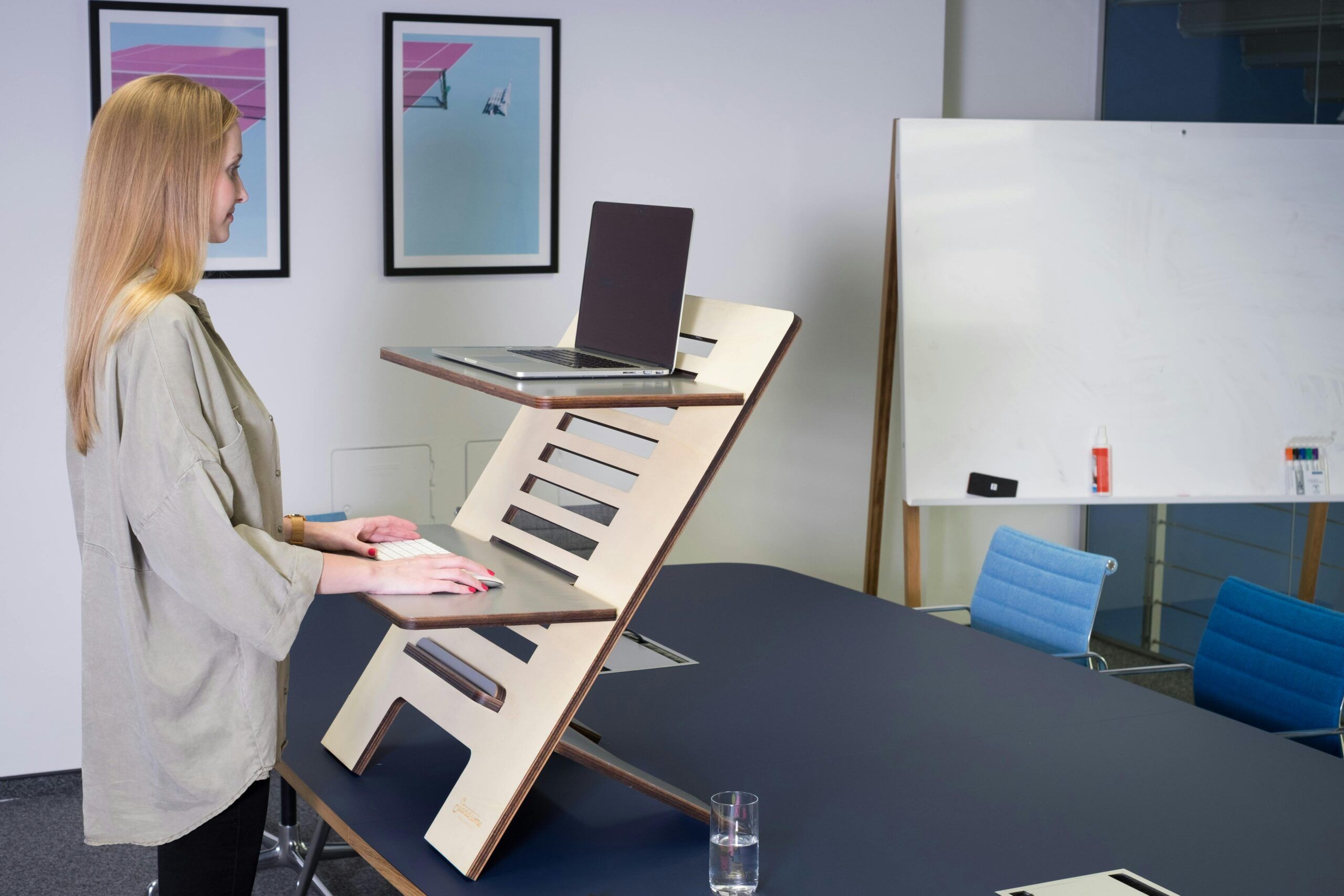Thursday 25th April 2024 marks On Your Feet Britain. This national initiative was created to get desk-based workers across Britain up and on their feet! In recognition of this, we’re using this blog post to discuss how you can #SitLess and #MoveMore.
Between seemingly endless meetings and deadlines, physical movement can often take a backseat when up against the demands of our busy working days. It’s alarmingly easy to find ourselves working late or skipping lunch breaks in favour of sitting at our desks for longer than we should, prioritising finishing work projects and time-consuming tasks instead of getting up, moving around, and fitting some exercise in!
We’ve all done it, but sitting down for prolonged periods can harm our health. Even just taking a few moments out for some light stretching or a short walk can do our physical and mental wellbeing the world of good. So, in recognition of On Your Feet Britain Day, in this blog post, we’re exploring how you can help yourself and your employees incorporate healthy movement habits into your daily schedules, going over some practical strategies for a more active workplace alongside suggestions on how to encourage healthy behaviours on a personal and organisational level.
The dangers of a sedentary lifestyle
When we refer to a ‘sedentary lifestyle’, we mean a daily lifestyle that is characterised by a lack of physical activity and exercise, as well as prolonged sitting of close to six hours a day. People with desk jobs are especially vulnerable to these types of sedentary behaviours as office workers tend to do their work sat down at a desk all day, every day. Remote workers and hybrid employees are also vulnerable to the health impacts brought about by leading a sedentary lifestyle, as almost all of their work is completed online.
In fact, according to the NHS, most adults in the UK spend approximately 9 hours a day sat down! Such prolonged inactivity has been directly linked to serious health problems, including the slowing down of the metabolism and an impeding of the body’s ability to regulate its blood sugar levels.
Such extended periods of physical inactivity can also lead to the following health issues that can impact your body and mind:
- Cardiovascular disease: A lack of exercise can cause fatty material to accumulate in the arteries, affecting their ability to transport blood throughout the body. These blockages can cause heart attacks or strokes.
- Obesity: A reduced metabolic rate due to a sedentary lifestyle can contribute to the build-up of fat deposits. This increases the likelihood of obesity and its associated medical issues, including diabetes.
- Musculoskeletal issues: Sedentary behaviours such as being hunched over a computer or desk without adequate breaks or stretching can cause joint stiffness, back pain, and neck strain.
- Anxiety and depression: Exercise releases endorphins in our body, chemicals that have been called the body’s ‘natural painkillers’. A lack of endorphins can negatively impact mood, as there aren’t enough endorphins circulating to reduce feelings of stress and worry. Unchecked, escalating stress responses can culminate in anxiety and depression, which can then impact your physical health too.
- Controlling blood sugar levels and helping to avoid diabetes
- Burning calories to maintain a healthy body weight
- Increasing brain sensitivity to serotonin, a hormone that counters feelings of negativity and stress
- Keeping the muscles strong
- Improving cognitive functioning by promoting the flow of oxygen to the brain through the increased heart rate
- Stimulating restorative processes during sleep on account of the physical energy spent
Time constraints and packed schedules are an everyday obstacle for office workers wanting to get some movement into their weeks. The good news? Research shows that as little as 22 minutes of exercise every day could help you and your employees feel physically and mentally fitter. This is according to research by the British Journal of Sports Medicine, where an increased risk of death was reported in people sitting between 8-12 hours a day and spending less than 22 minutes on exercise. These 22 minutes of MVPA – moderate to vigorous physical activity – were proven to significantly lower this risk.
Facilitating more active days: practical strategies for healthier workplace habits
The logistics of the workspace and the organisation of the working day are probably making it harder, not easier, for your employees to get adequate movement into their weeks. A culture of prolonged meetings that frequently run over, limited breaks, long hours spent typing on a computer, and a lack of physical space in the workplace can all make it harder to incorporate more movement into our working days.
However, not every action to limit the impact of sedentary jobs on our health and wellbeing has to be big. Small, incremental changes can have a lasting positive impact on you and your employees’ health. These include:
- Encouraging your team to take frequent breaks to help them get away from their desk and take a walk, change their posture, do some stretching, and get some steps in away from the constraints of their workstation.
- Changing the physical office layout to allow more space for changing working positions (e.g., using a standing desk instead of a seated one), having a walk around, and stretching.
- Offering standing desks to offset hours spent seated.
- Introducing walking meetings outdoors or encouraging your team to use phone calls as an opportunity to get some fresh air while they speak.
- Providing a designated exercise area or office gym for employees to work out before/after work or at lunchtime.
- Organising outdoor team-building events such as group runs or walks, friendly sporting tournaments, and lunchtime yoga or other fitness sessions. (This can also be brilliant for strengthening inter-colleague relationships and creating friendships).
These measures are brilliant for encouraging more movement on a team-wide level. However, it is equally important to communicate health strategies and suggestions to your employees so that they may take their own steps towards a more active lifestyle. The top 7 simple suggestions for more movement include:
1. Wearing trainers to the office to facilitate an easy transition to exercise/make it easy to go for walks during the day and get outside on your lunch break. You can take another smart pair of shoes with you or leave some at the office ready to change into.
2. Walking to work to get some steps into your commute. If the commute is too long to do this and you need to get the bus/train, consider getting off public transport one or two stops earlier than you usually would when going to the office or heading home to squeeze in a walk.
4. Walking up the escalator or taking the stairs instead of jumping in the lift!
5. Habit-stacking to make fitting more movement into your day automatic, i.e. pairing exercise with behaviours or habits already engrained into your day. For example, this might mean doing some squats while waiting for the kettle to boil, practising shoulder rolls during an online meeting or call, taking deep breaths or doing some isometric exercises while reading emails, or doing standing calf raises while waiting for the microwave to beep or someone to pick up the phone.
6. Downloading a fitness app or wearing a fitness-tracking watch that reminds you to take exercise breaks and stand up from your desk by setting goals for movement based on your daily activity levels.
7. Taking some time out to exercise before or after work. For example, getting in a quick 10-minute run before breakfast, taking an evening stroll after dinner, or planning some outdoor adventure or sporting activity on the weekend to counteract a more sedentary working week.
8. Finding an exercise buddy in the office to help motivate you to get up and move! As colleagues, you can remind each other to take a break from your desks and go on a walk together during a tea or lunch break in order to fit more movement into your days.
Physical inactivity in the office is a serious concern. The World Health Organisation links sedentary lifestyles with around 2 million deaths per year globally, highlighting sedentary behaviours as one of the top 10 causes of death in the world.
According to the BBC, around 37% of male and 45% of female workers spend less than 30 minutes a day off their feet in the office. This level of physical inactivity can be offset by the simple suggestions highlighted above, promoting healthier work and general lifestyle habits for your employees, making way for better physical and mental wellbeing.
Encouraging movement across the organisation: wider steps for change
In addition to the practical strategies and suggestions for healthier individual habits in your employees, you and other members of senior management can implement wider organisational changes that support healthy behaviours for all. At Thrive4Life, we can help you transform your workforce’s health and wellbeing by helping you and your team prioritise your physical fitness in the following ways:
1. Thorough expert evaluation: Our highly experienced wellbeing consultants can evaluate your workplace and team’s needs to identify the areas of your wellbeing strategy which could be improved. We can then provide bespoke advice and outline the steps you need to take to improve your staff’s wellbeing. If it’s sedentary working patterns you’re looking to counteract, this might include organising initiatives to increase your employees’ level of physical activity during the working day, for example.
2. By conducting health and wellbeing activities: At Thrive4Life, we offer a portfolio of expert services to determine health risks and increase personal awareness of key health issues, e.g., in this instance, those relating to physical inactivity. For example, with our 15 or 20-minute ‘Know Your Numbers’ Mini Employee Health Checks, your team can get readings on their key health indicators, including BMI, blood sugar levels, and cholesterol levels, to help them better understand their bodies and what steps they need to take to improve their health.
For more extensive health assessments and solutions, you can also book one of our Staff Wellbeing Challenges for your team, in which our expert nutrition and wellbeing coaches guide your team through a 28-day initiative designed to help you and your employees improve your diet and lifestyle habits for greater energy, better physical and mental health, and a refreshed and renewed sense of wellbeing.
3. With expert resources and guidance: Raising awareness is key to tackling any problem, and we can help your employees better understand the seriousness of a sedentary lifestyle’s impacts on their health while providing suggestions and tips on how to fit more activity into your working days.
One of the ways you can do this is by purchasing access to our Employee Health and Wellbeing Discovery Hub, which contains a wealth of fully-designed articles on a wide range of health and wellbeing topics. This can be extremely helpful in giving employees more information about the main pillars of health and wellbeing and how they can lead healthier and happier lives, both inside and outside of work.
Additionally, subscription to our monthly Health and Wellbeing ePublications can help promote awareness of the importance of daily movement and focused exercise (as well as a huge range of other topics and issues pertaining to physical and mental health and lifestyle).
Your employees can consult both the Hub and our monthly ePublications at any time they like.
Furthermore, you can also book onto our Wellbeing Webinars, health and wellbeing-related talks led by medical consultants and wellbeing experts, which are live-streamed to your employees. These talks are an invaluable way of learning more about your physical and mental health and helping your team learn how you can all lead healthier lives.
Conclusion:
In recognition of On Your Feet Britain Day later this week, from wellness challenges to habit-stacking, we want to encourage any and every individual and organisational effort to incorporate more movement into your working days and promote physical activity to safeguard you from the harmful impacts of a sedentary lifestyle on the long-term health and wellbeing of you and your employees.
As discussed in this blog post, disease prevention, better cognitive abilities, and renewed energy are only a few of the many benefits of regular physical exercise. By modelling healthy behaviours and implementing the suggested strategies for a more physically active working culture, you can inspire your colleagues and employees (and yourself!) to incorporate more movement into their schedules – ensuring that personal health and professional wellbeing and success go hand in hand.










